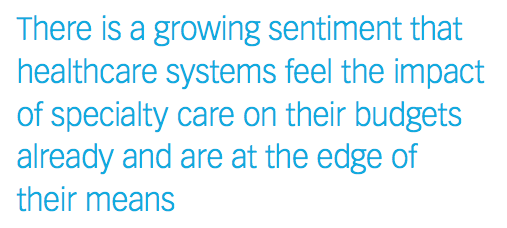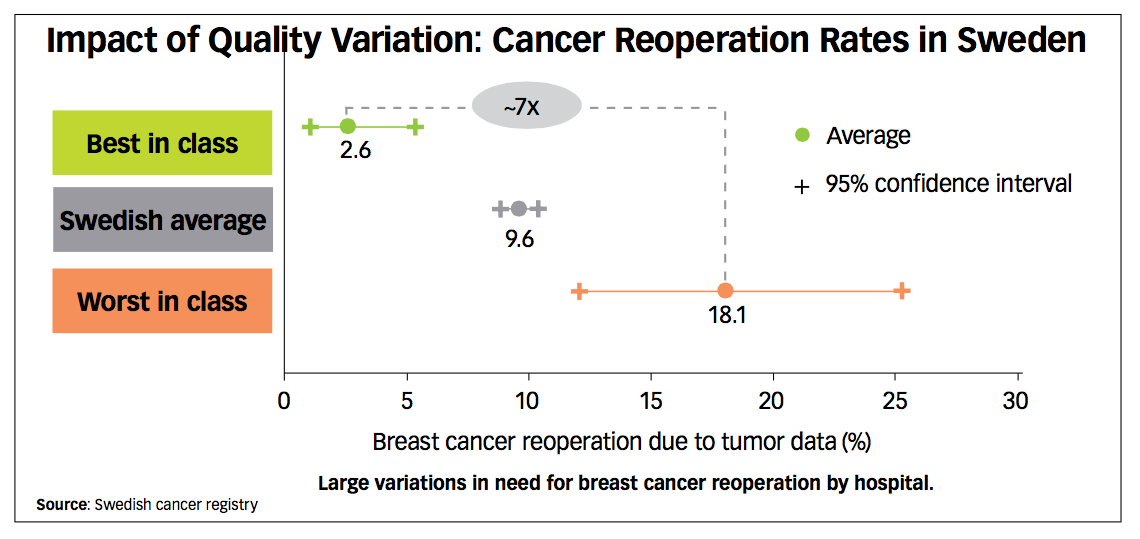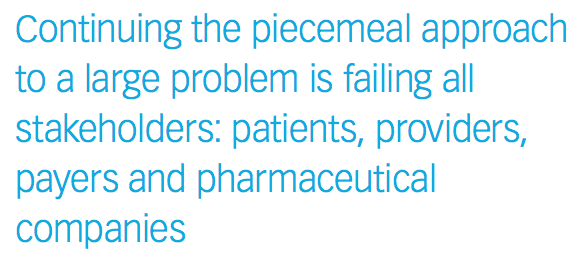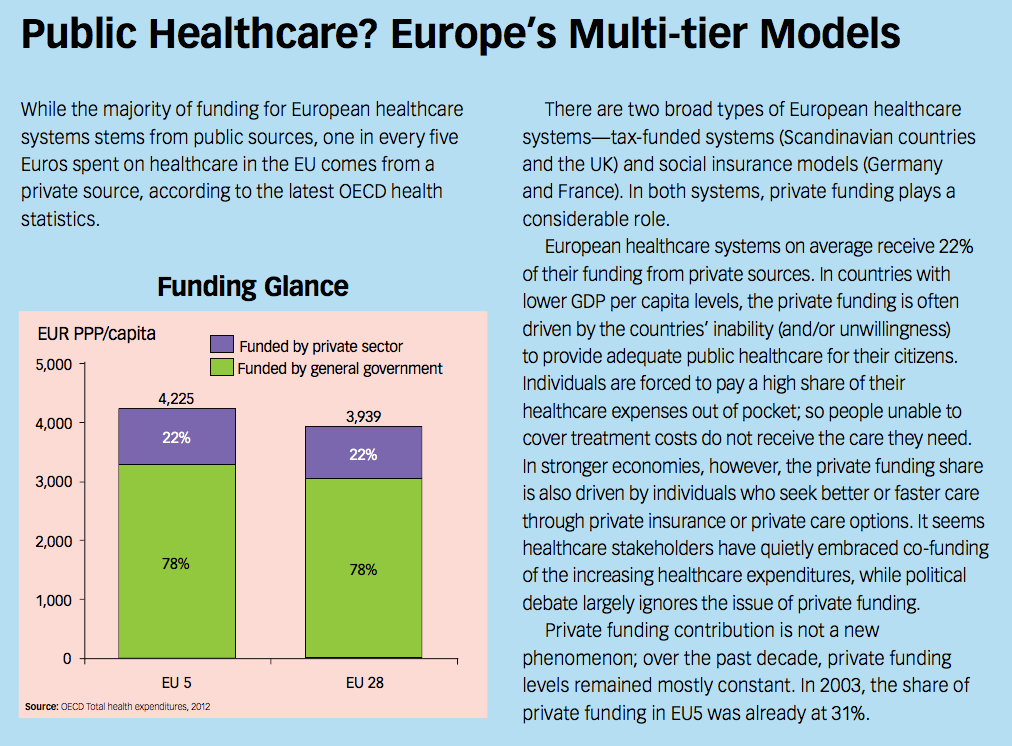Market Access in Europe: Building Health Equity Through Better Outcomes
Pharmaceutical Executive
A new industry working group explores alternative drug funding options in Europe-and asks key stakeholders in the region to join the discussion.
There is a growing awareness within the European Union that healthcare systems are socioeconomically vulnerable. Many stakeholders recognize that far-reaching changes are required in order to ensure sustainable patient access to high quality healthcare in the future. Opinions differ, however, on how countries should address the economic pressure without limiting access to care.
Current approaches to managing healthcare budget constraints remain piecemeal, putting broad patient access to innovative treatments across Europe at risk. To optimize the quality of care as well as achieve cost efficiencies, the total healthcare value chain across stakeholders should be addressed. The current focus on innovative treatments falls short. In addition, current efforts do not address the high variation of health outcomes among different healthcare providers within and across countries-a fact that is unknown to most patients.
In order to address the sustainability challenge and improve the quality of care, healthcare systems ought to shift their focus to patient-relevant outcomes that use existing resources more effectively, and explore alternative funding sources to alleviate the burden on publicly funded systems.
Convening power
The Boston Consulting Group (BCG) Market Access Roundtable is a forum that

brings together senior pharmaceutical leaders in market access and serves as a platform for interactive discussion on industry level topics.
In light of the ever more pressured healthcare systems in Europe, the Roundtable created a working group to explore and analyze financing of novel therapeutics in Europe beyond traditional approaches. This paper summarizes the outcome of the work conducted over the past year, and proposes two strategies designed to promote efficiencies through better outcomes and increase options for additional system-wide funding.
Statement of problem
European healthcare systems are increasingly unable to provide equal access to specialized care-yet there is still no broad discussion involving all stakeholders
European healthcare systems are under pressure today and in the near future the situation is expected to become even more challenging. Across the European Union (EU), factors such as an aging population and increased incidence of chronic diseases are stretching healthcare systems, requiring greater healthcare spending at a time when there is increasing economic pressure on public funding.
At the same time, advances in scientific and technological research are opening up new, promising treatments for previously difficult to treat diseases, increasing the demand on already constrained healthcare budgets. As a consequence, European countries either have to spend an increasing share of their GDP on healthcare or limit access to some aspects of it to contain costs. As the sustainability of healthcare systems is contested, societies must contend with questions such as, “what level of healthcare access is appropriate/expected?” and “how should healthcare be financed?” Yet despite growing concerns, the lack of a broad discussion involving all stakeholders is painfully apparent.
While a funding gap could be detrimental to all aspects of healthcare delivery, access to new, innovative, and specialized care seems to be particularly at risk
Scientific progress over the past several decades has made many previously deadly diseases manageable, prevented and cured some serious illnesses, and even eradicated some diseases outright.
Today, many so-called primary care diseases are well treated at reasonable costs. Similarly, increased diagnostic possibilities and new medical devices have expanded our diagnostic options and surgical interventions.
Currently the biggest unmet medical need is for care for complex specialty diseases such as cancer, Alzheimer’s disease, and immunological disorders. In response to this, over the last few years, the biopharmaceutical industry has shifted its research efforts to developing new treatments for specialty diseases. In 2014, almost 50% of newly FDA-approved drugs were specialty drugs, whereas 10 years ago this was below 30%.
At the same time, as scientific focus shifts toward developing new, innovative medicines to treat the highest unmet medical need, payers and

systems increasingly find themselves unable to appropriately fund specialty care treatments due to the fragmentation of drug budgets and constraints on total healthcare budgets. As a consequence, healthcare systems have focused efforts to control spending on medicines, as drug budgets are easily targeted. These efforts clearly cast doubts on healthcare systems’ ability to maintain and expand access to new, innovative treatments in the future.
There is a growing sentiment that healthcare systems feel the impact of specialty care on their budgets already and are at the edge of their means. Inevitably, payers will put more emphasis on cost containment in previously less scrutinized areas such as cancer care, and, therefore, limit the expansion of patient access to life-saving specialty treatments.
Two overarching observations
1.) Current approaches to containing costs remain piecemeal and siloed-and result in unintended unequal access to medicines across Europe
Unable to sustain increasing healthcare expenses given increasing public budget constraints, most countries in Europe have deployed measures to limit healthcare expenditure growth. Since 2003, there has been continued pressure on healthcare spend, but it has accelerated in the years following the financial crisis. Total healthcare spending growth in EU was reduced from 7% in 2003 to 2008 to 3% in 2008 to 2012.
Enacted initiatives remain piecemeal and often only look at particular parts of the healthcare budget, failing to address the issue in a comprehensive manner. Expenditures on prescribed medicines have garnered the most attention, despite accounting for only about 13% of total healthcare spend. Inpatient/outpatient care provision accounts for a majority of total healthcare spending.
In the area of health technology assessment (HTA), despite widely agreed-upon definitions of “health technologies” that include medicines, diagnostics, devices, and medical procedures, the vast majority of HTA agencies focus largely on medicines and not other significant areas of healthcare spending. As a consequence, investment in medicines shrank by about 2% while overall healthcare expenditures grew by about 3% from 2010 to 2012 across most markets in Europe.
Varied implementation of efforts to contain healthcare costs, for example, delaying access through a later launch, usage limitations through reimbursement decisions, or spending caps, led to wide inconsistencies in access to medicine. Not surprisingly, the cost of reduced access is disproportionately affecting those least able to pay.
Looking at population size-controlled volume consumption of innovative medicines across Europe, we observe a thirtyfold difference between the countries with the lowest and the highest consumption of innovative anti-diabetics in 2012. Volume usage patterns broadly follow the GDP/capita distribution, with Luxembourg using most and Bulgaria least.
Even today, patients in Europe have very differing health prospects depending on in which country they fall ill, which puts in question the very idea of a pan-European equity in healthcare.
2.) Patients are not guaranteed the best available treatment
Health outcomes for the same condition or treatment can vary dramatically between countries and even within countries across different providers. Patients, and more strikingly, health systems officials, seem unaware that the choice of healthcare provider can have a dramatic impact on health outcome.
Data from the Swedish cancer registry reveals that breast cancer patients are up to seven times more likely to require reoperation depending on in which hospital they are treated. Looking only at university hospitals, the difference between best and worst in class is still more than threefold (see chart).

Such outcome variation is common across Europe. For example, in the UK, patients receiving primary hip replacement surgery in the lowest-ranking hospital are six times more likely to require emergency readmission within 28 days than patients receiving care in highest ranking one.
Such vast variation suggests that pockets of care-providers have developed superior treatment standards, and thus deliver better outcomes while others fail to provide their patients with the best possible care. Contrary to popular belief, better outcomes don’t have to come at an increased cost. As providers look to deliver holistic care that focuses on improving outcomes, costs to the healthcare system can also be reduced. One example is the tracking of cataract outcomes and identification of best practices in Sweden by a national registry that improved postoperative endophthalmitis rates by 80% while reducing costs by 1%. In Germany, “Gesundes Kinzigtal” tracked outcomes and optimized care for chronic patients with a focus on prevention and wellness. This reduced mortality rates by 53% and resulted in a saving of â¬151 per patient.
Rethink financing of specialty care
The discussion on how we, as society, ensure the continuous provision and expansion of access to specialized care is a pressing one. Current cost and funding outlooks paint an unsustainable picture for the future, and in many European countries the funding and access situation is bleak. Clearly, current approaches to cost containment have not been successful.
Continuing the piecemeal approach to a large problem is failing all stakeholders:

patients, providers, payers, and pharmaceutical companies. A broad debate on what level of healthcare access is appropriate or expected and how such healthcare should be financed is required to foster a holistic approach to sustainable access to specialty healthcare in the future.
Broadly, there are two approaches to ensuring healthcare systems are able to maintain and expand access to specialized, innovative healthcare in the future:
- Better utilization of existing resources
- Enabling additional funding/payment options
Better utilization of existing resources targets unnecessary or ineffective healthcare spending. An estimated 30% of total healthcare spending in the US is unnecessary. This share may be lower in Europe, yet it is still far too large to be ignored. Putting resources to better use could limit or even prevent the growth of healthcare costs for many years.
But even with better utilization of current funding, maintaining and expanding the quality of and access to healthcare might not be possible everywhere in the EU. As public funding pools are already limited, it would be wise to explore whether additional funding from non-traditional (such as non-public) funding pools could help relieve the pressure on public healthcare systems.
It is widely acknowledged in academia that given the large differences in national healthcare systems in the EU and the current funding levels and sources, there is no silver bullet for European healthcare. This white paper attempts to lay out different options to improve the utilization of existing resources, and proposes alternative funding options which could support and supplement public funding more effectively.
Our two proposals
1. Better utilization of existing resources
Current levels of healthcare funding could go further if resources were used more effectively. The European Commission writes, “Efficiency gains could translate into a 0.5% reduction in the annual growth rate of public health expenditure, eventually halting the increase in the public healthcare expenditure-to-GDP ratio in the EU over the long-term.” The World Health Organization (WHO) already in 2010 pointed out that “At a conservative estimate, 20â40% of health resources are wasted.”
Ineffective use of resources has many causes. Key among them are unnecessary or ineffective tests, lack of appropriate early diagnosis and intervention, and dysfunctional patient pathways, including treatments either driven by “defensive medicine” or by misaligned incentives of the reimbursement system. To address suboptimal use of medicines, healthcare payers are starting to implement measures to drive down the inefficiency in the prescribing and use of medicines. In Italy, for example, the payer reimburses the cost of certain cancer drugs after response is ascertained by the physician and documented by means of a therapy registry.
Many pharmaceutical companies are open to contributing to better use of medicines through so-called pay-for-performance reimbursement schemes. Under such reimbursement agreements, the payer only pays for the medicine if it provided a substantial, pre-defined patient outcome. The healthcare system thus only bears the cost for positive outcomes. Key to establishing pay-for-performance systems are outcomes registries to track how patients respond to certain treatment options. Unfortunately, only certain diseases in a few European countries are tracked to date.
The key to any approach to better utilizing existing funds is a focus on outcomes to define the optimal use. Luxembourg, for example, is now asking whether the assessment of the performance of health systems should focus on the effectiveness of healthcare (specifically outcomes), as a main contributor to healthcare quality and better health of the population.
A focus on outcomes ensures that healthcare systems as a whole focus resources on the most important goal: to improve patients’ health. At the same time, a focus on outcomes can also reduce costs. We believe that if patient-relevant outcomes
SIDEBAR: click to enlarge

are measured in a transparent and standardized way, a focus on outcomes could push all healthcare providers to provide care equal to best-in-class in the most cost-effective way.
In 2005, Sweden began to collect data on whether hospitals were adopting best practice when treating acute coronary syndrome. Data showed that a 13% improvement year-on-year was being achieved. When the findings were made public, and individual hospitals named, the year-on-year improvement jumped to 22%. Furthermore, in the U.S., a registry was created to track outcomes and best practice implementation of cardiac care. The end result was a 73% reduction in the risk of dying from a cardiac-related cause.
As these examples illustrate, there is great value in measuring and reporting outcomes across healthcare providers, treatments, and medicine in a standardized and transparent way. Making outcomes data publicly available would lead to a healthy competition for patients. Patients selecting the provider with the best track record would reward the best providers with higher volumes, which in turn drive down the costs. The Martini Klinik in Hamburg, Germany, became the largest prostate cancer center in Europe through better patient-relevant outcomes, and can now offer lower-cost treatments.
Further, an outcomes focus enables providers to learn from each other and drive lower-performing providers to adopt better practices and standards. An outcomes focus can thus improve equity, quality, and cost of care across all providers and treatments if implemented across the healthcare value chain.
Given the broad benefits, the Luxembourg Presidency of the Council of Europe (2015) proposes to pursue the discussion by stressing access and outcomes. However, in some European countries, better utilization of existing resources may not be enough, as current total public healthcare spending does not provide adequate access. Additional funding options have to be explored in order to safeguard patient gains and maintain access to innovative treatment options across Europe. Outcomes tracking and optimization can build the foundation for alternative, additional funding options.
2. Enabling additional funding options
A system-wide focus on transparency of outcomes could also open the door to more targeted, non- traditional funding mechanisms. Focusing on outcomes provides a clear value-for-money picture of alternative funding options. All approaches to healthcare funding in the future would require an understanding and demonstration of the return on investment, in this case, the health outcome. Only when the healthcare system can clearly articulate what works will we be able to attract other, supplementary funding for certain aspects of care provision. In turn, alternative funding sources are likely to require the entire healthcare value chain to track and optimize outcomes to deliver a value-for-money promise.
Given the different healthcare and healthcare funding systems, disease types, and treatment options, a range of potential non-traditional funding options is feasible. We acknowledge that many of these non- traditional funding mechanisms are already in place across the EU in pockets (out-of-pocket, private insurance, pay-for-outcomes). However a public debate on the role they could play in the future is missing. We also recognize that not all options are viable in all markets, but in the spirit of initiating a debate, we take a holistic approach without focusing on any given EU healthcare system. We have proposed a range of potential solutions that could enable additional investment in healthcare and help fund future innovation. We are not suggesting that any one solution could work in isolation or for all European countries. Most likely, a combination of these potential solutions will be required across Europe, depending on the current makeup of a country’s healthcare funding levels and systems.
Out-of-pocket/co-payment
Perhaps the simplest form of expanding private support for healthcare expenses could be through expansion of out-of-pocket or co-payments. Historically, out-of-pocket payments have been used mostly as a tool to control the overuse of medicines and healthcare services. Through such out-of-pocket payments, payers encouraged spending limits by asking patients to pay a share of the costs. However, an extension of out-of-pocket contributions could also have a more direct effect by supporting healthcare funding.
One option could be to invite a greater share of private funding to cover primary disease treatment, and as a consequence, public funds would provide broad access to life-saving critical care and innovative specialty products. Medicines for primary diseases would be most suitable for higher out- of-pocket/co-payments given the lower price range and often more elective usage pattern. The cost burden for primary care patients would certainly increase, yet patients would receive better access to potentially life-saving treatments should they need them. Maximum absolute co-payments would certainly have to differ per country due to different GDP- and income-levels.
An increase in out-of-pocket and co-payments could be funded by the patient directly, covered by new private insurance policies targeted towards these expenses, or by employer coverage. All these options require individuals and patients to make decisions about their healthcare options, therefore they need to be well informed about the benefits and risks of all the treatment options at hand. Today, patients are often not fully aware of new treatment options and the benefits of innovative treatments or how much treatments and doctor visits cost.
A higher share of out-of-pocket funding could in turn trigger a broader focus on outcomes, as patients who co- or self-fund treatments will carefully examine which treatments they are willing to invest in. Scrutinizing the perceived cost/benefit ratio of treatments from the patient perspective immediately forces healthcare providers to focus on the most effective use of resources and could trigger additional pressure to move towards an outcomes-focused healthcare system.
Private medical insurance
Private medical insurance to either supplement or replace public healthcare coverage is available in many European countries. In France, 95% of the population bought supplementary (or top-up) insurance to receive additional or better care, and in Germany 11% of people opt out of the public system and buy private insurance instead, while another estimated 22% complement their statutory health insurance with private insurance. As their presence grows, private insurance models are increasingly being debated. Given the history of public healthcare in Europe, private insurance models are often still viewed negatively, for fear of them paving the way to a “two-class” healthcare system. Yet despite often being cited as a challenge to equality in healthcare, individuals are open to funding a share of their health expenses privately in order to receive additional, faster, and/or better care.
Private insurance could come in different forms. Supplementary insurance would ensure additional services or faster access above and beyond the care provided by the public system. Alternatively, individuals could opt out of the public system and seek only private insurance (potentially with a government subsidy-as these people are no longer a cost item to the public system). Finally, private insurance could cover specific services or treatments such as rehabilitation.
The common benefit of all insurance options is that they provide some relief to the public system and thereby help ensure that public systems can provide and expand access to adequate healthcare to its citizens. Higher private insurance levels would help ensure that all patients receive the best care possible for life-threatening accidents and illnesses. Key to a broader engagement with private insurance is that patients and lawmakers understand how private insurance models could be part of the solution.
Similar to out-of-pocket payments, increasing the role of private insurers will trigger a broader emphasis on outcomes and optimal utilization of resources across the healthcare value chain. Opening up options for private insurance thus not only helps increase the total investment in innovation, it also helps reduce the total costs of the public healthcare system.
Employer-supported healthcare models
Better access to innovative healthcare not only benefits each individual, employers also stand to gain from a healthier workforce. Healthier employees are more productive, as many studies have highlighted. And while high quality preventive care can help employees avoid sick leave in the first place, the possibility of early detection of diseases can also do away with the necessity for invasive treatments which require employees to take longer leaves. For employees who suffer from diseases that cannot be prevented at an early stage, innovative therapies can shorten the time an employee spends in treatment, away from the workplace.
As employers clearly benefit from expanded access to healthcare, it is not unreasonable to require greater support in the form of funding. In addition to helping mitigate the sustainability issue, making employers part of the solution would have positive secondary effects. For one, employers would have an even greater incentive to focus on preventing ailments in their workforce. In many cases, prevention is cheaper than treatment. Secondly, it would involve employers more in establishing healthier workplaces and promoting a healthier lifestyle.
Deeper employer support for public healthcare systems could take several forms. Governments could mandate that employers above a certain size provide supplementary health insurance to their employees. Such an approach could lead to employers buying supplementary insurance coverage from private insurance providers (similar to the US model). Employers are able to bundle the coverage of many individuals, thus negotiating better rates than individuals can. This also plays a role in reducing overall healthcare costs. Another option would be to require a contribution from employers directly with the proceeds supporting the funding of the public healthcare system.
New payment models
Even with additional funding models in place, curative medicines and gene therapies will continue to pose challenges for payers. Curative medicines, as the name suggests, cure diseases, while gene therapies treat disorders by replacing, inactivating, or introducing genes with a single injection. Next to the obvious health benefit for the patient, such medicines and therapies relieve the healthcare system of all future costs it would have faced over the period of the disease or the lifetime of the patient (for example, ongoing treatment, hospitalization, and/or future surgery). Providing such curative care to all eligible patients quickly goes beyond predefined healthcare budgets, as we have witnessed in many countries where access to new hepatitis C virus (HCV) drugs has already been achieved.
To find new solutions to fund such treatments we have to look at healthcare not as an expense, but as an investment. Investments (for example, buying a house) carry a high upfront payment, but the benefits are enjoyed throughout the asset’s lifetime. Curative medicines also require an initial investment and provide a continuous benefit thereafter. An investment is often co-funded by third parties who provide debt. Similarly, one could explore whether a third party could provide debt to finance the initial investment which the payer could then amortize over a period of time and thus staggering the cost of one time investment (for example, gene therapy, HCV clearance) over several years of benefit.
Alternatively, health savings accounts could enable patients to save a portion of the funds required to cover future healthcare investments. In such a model, individuals could pay into a specialized health savings account and accrue the funding for future treatments. Of course, many individuals may not be able to save enough to cover larger surgeries or cancer treatment if they are needed within a few years. Therefore, such health savings accounts would also aim to cover common/primary care diseases, while the public system covers the more cost-intensive surgeries and specialty care.
Similar to expensive one-time curative treatments, the treatment of lifelong chronic diseases increasingly poses financial burdens on Europe’s healthcare systems. Thanks to medical and technological advancement, more and more previously fatal diseases can be managed as chronic diseases.
These are initial thoughts on what new payment models could look like. Clearly a more detailed debate with all relevant stakeholders at the table is required to define and test new models.
It is, therefore, not a question of either better utilization of existing resources or looking for alternative funding options. Both approaches are required, given the different starting positions and intricacies of healthcare systems in Europe today and given that they reinforce each other. A focus on outcomes to better utilize existing resources builds the foundation for alternative funding sources to participate in funding healthcare. In turn, private funding sources only invest in treatments with positive outcomes, which forces healthcare systems to track outcomes very closely.
Initiating debate: The time is now
The current situation of healthcare funding in Europe is not sustainable. An aging population, the increase in chronic disease, and the development of new, specialty treatments, all add to an already stretched public healthcare budget. At the same time, current efforts to contain costs are piecemeal and siloed, focusing on single elements of the overall value chain rather than taking a holistic view.
A shift to outcomes-focused healthcare, where all stakeholders focus on improving outcomes, can result in better care for patients and better utilization of existing resources. In addition, the need to explore alternative funding options is also becoming evident.
While we acknowledge that current healthcare systems across Europe all have different starting positions and face different challenges, and that no single solution is universally applicable, we do believe that European societies need to begin a discussion on healthcare financing now. Any change in financing healthcare will require considerable time-decades rather than years-and strong political/societal willingness for change.
